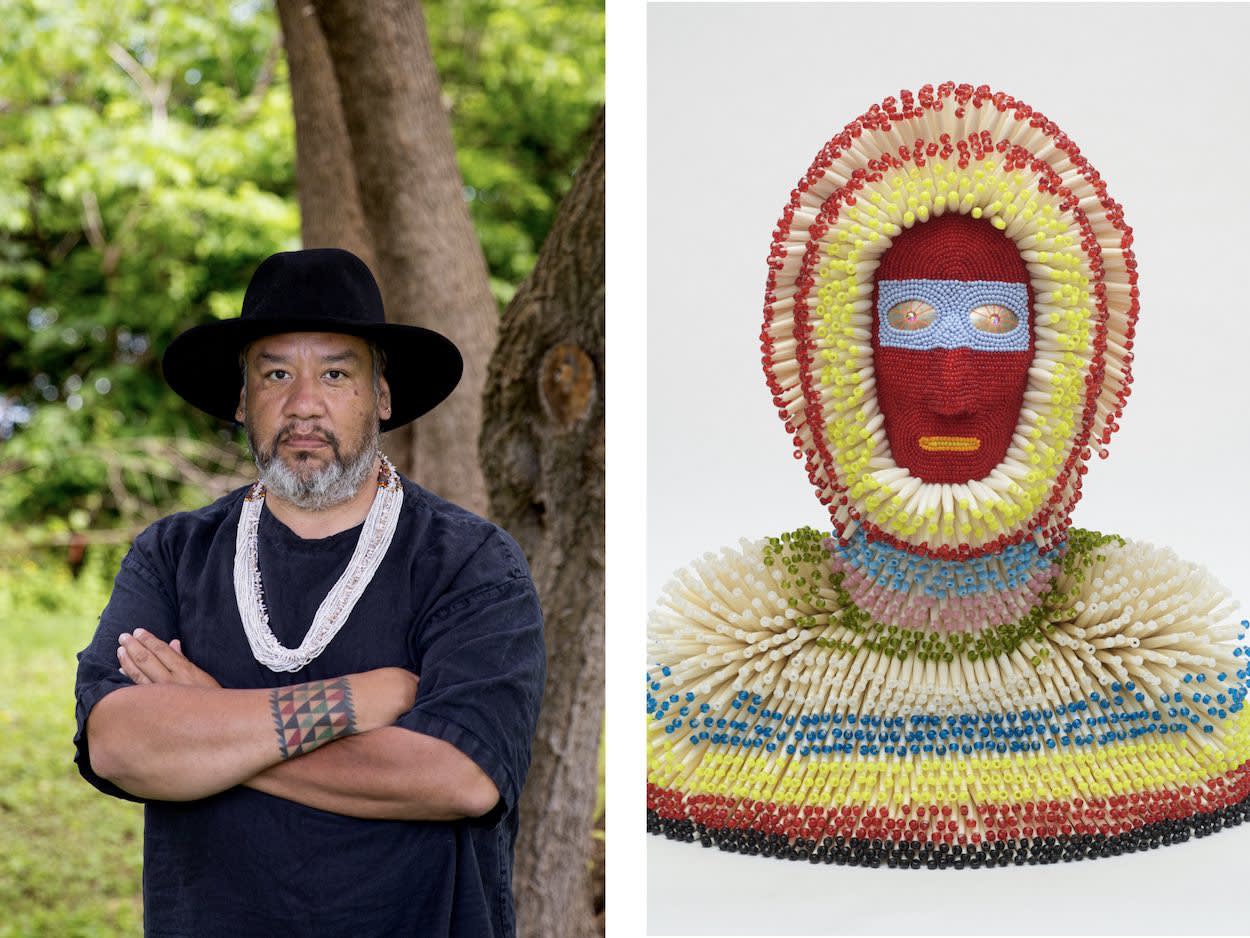
New York City Ballet has entered 2023 with a slate of art- and design-world collaborations. The headliner: Jeffrey Gibson's visual design for Justin Peck's newest ballet.
Copland Dance Episodes, an abstract new ballet from New York City Ballet resident choreographer and artistic advisor Justin Peck, premieres tonight at Lincoln Center’s David H. Koch Theater. It’s something of a generational turning point: Peck’s is the first new non-narrative, evening-length performance to join the company’s repertory since 1967.
For the production’s visual design, he worked closely with the contemporary artist Jeffrey Gibson, whose two massive fabric drops for the performance’s opening and closing curtain recall the kaleidoscopic geometry of his quilted textile art and vibrant acrylic-on-canvas paintings. Drops are traditionally a crucial piece for stage scene-setting, but in a non-narrative work like Peck’s, they instead inspired the variety of color—citrine, turquoise, magenta—in the costumes designed by former City Ballet dancer Ellen Warren. “This ballet world is very different from the world I operate in,” Gibson tells Surface. “Ballet is not like the art world, which kind of thrives on something shocking or different, or that breaks away from tradition.”
For the company, whose box office juggernauts include founding choreographer and artistic director George Balanchine’s Swan Lake and the Nutcracker (both set to Tschaikovsky scores), Copland Dance Episodes represents an evolution at a time when other arts organizations like the neighboring Metropolitan Opera are scrambling to sate an appetite for contemporary works.
Peck has played a pivotal role in helping the medium of dance reach new audiences, inside and out of David H. Koch Theater. The New York Times credits him with pioneering the now-ubiquitous use of stylized trailers to promote new ballets. He has also honed his eye for activating vast expanses of space by choreographing for Broadway and films, most recently Steven Spielberg’s West Side Story (2021). Through his collaborations with outsiders to the insular world of ballet, like the musician Sufjan Stevens, the fashion brand Opening Ceremony, and now Jeffrey Gibson (pictured below), he has kept the art in step with defining cultural influences instead of in a vacuum of its own history and traditions.
“I was excited, of course, when Justin called me because New York City Ballet really is inherent to the fabric of New York City,” Gibson says. “The narrative of my work, which has always been my drive, is my want to find unexpected places where I can mark presence and existence.”

L: A portrait of Gibson; credit: Brian Barlow. R: 'PPPPPOOOOOWWWWWEEEEERRRRR', a sculpture by Gibson.
Copland Dance Episodes is set to four Americana-inflected scores of the composer Aaron Copland’s music: Rodeo, Appalachian Spring, Billy the Kid, and Fanfare for the Common Man. The choreography for Rodeo is partially inspired by Peck’s eighth ballet for the company, Rodeo: Four Dance Episodes, which premiered in 2015 when Peck was just 27 years old and both dancing and choreographing for City Ballet.
“When I started looking at Aaron Copland, these particular scores, the Americana, I thought, ‘I could twist this in so many ways. The time period of the ‘30s and ‘40s was not a good time for native people,’” says Gibson, whose artwork is informed by his Chocktaw and Cherokee heritage, as well as Indigenous craft traditions. “Justin twists it by pairing men with men and women with women, in dancing.”
Fourteen years into his choreographic career, much has been written about Peck’s signature style, which feels rooted in subverting audience expectations and classical conventions. His collaboration with Gibson, particularly on a work set to four of the composer Aaron Copland’s Americana-inflected scores seems to mark a new era for how the choreographer is pushing the needle. Gibson’s opening stage drop is informed by Indigenous architecture and incorporates the mantra “the only way out is through.” He says the motto aligns with how he thinks about politics and social strife. It all seems to show that Peck’s affinity for subversion extends to upending the cultural context of the rah-rah nationalism surrounding Copland’s works and the stereotypes of the Wild West. “I know Justin is aware of these things because we’ve talked about them,” Gibson says.



